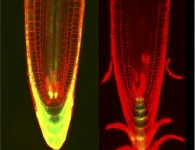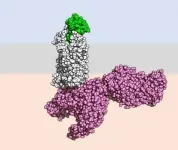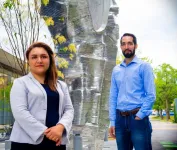Damage control: Plants juggle genome maintenance and growth by being organized
Researchers from Nara Institute of Science and Technology find that control of the plant hormones cytokinin and auxin help damaged plants to minimize cell death while maintaining their genomes and organ development
2021-06-16
(Press-News.org) Ikoma, Japan - Humans pride themselves on being able to multitask, especially under pressure. But it turns out that we aren't the only ones who are organized: researchers from Japan have discovered that plants balance genome maintenance with organ growth by organizing different responses to DNA damage.
In a study published in Science Advances, a research team led by Nara Institute of Science and Technology has revealed that plants use combined control of the plant hormones cytokinin and auxin to organize DNA damage responses while maintaining growth.
Plants are highly adaptable organisms that never stop growing, thanks largely to the functions carried out by their roots. Because of the essential role that roots play in plant growth, root development is highly responsive to fluctuating conditions underground, including environmental stresses. These stresses tend to limit root growth, and can damage DNA.
"Plants actively respond to DNA damage, and these responses are controlled by the cell cycle checkpoint mechanism," says project leader Masaaki Umeda. "The cell cycle is stopped at a certain stage so that DNA can be repaired, or in extreme cases, cell death initiated. What we wanted to know was how the DNA damage responses are organized to allow continuous root growth."
Unlike animal cells, plant cells aren't mobile, so plants can't replace dead cells with surrounding living cells. To simultaneously maintain their genomes and allow organ development, plants initiate different DNA damage responses that are dependent on the different types of cells in tissues.
"We found that the combined control of two plant hormones, cytokinin and auxin, organizes different DNA damage responses at the cost of minimized cell death," explains first author Naoki Takahashi. "This is a sophisticated way to retain stem cells while maintaining their genomes in damaged plants."
A decrease in auxin triggers stem cell death and stops the cell cycle at the G2 phase, while increased cytokinin signals support early endoreplication - a cell cycle variant where the genome is duplicated without cell division.
The study explains previously unidentified mechanisms of keeping genomes stable in a developmental setting, which allow continuous organ growth in fluctuating environments. The results of this study will have wide-ranging applications to research on agricultural technologies, particularly for plant growth and development in extreme environments. Future studies will illuminate how plants develop organs beyond the embryonic stage via the maintenance of genome stability in changing conditions.
INFORMATION:
Resource
Title: Alterations in hormonal signals spatially coordinate distinct responses to DNA double-strand breaks in Arabidopsis roots
Authors: Naoki Takahashi, Soichi Inagaki, Kohei Nishimura, Hitoshi Sakakibara, Ioanna Antoniadi, Michal Karady, Karin Ljung & Masaaki Umeda
Journal: Science Advances
Information about project leader Umeda's lab can be found at the following website: https://bsw3.naist.jp/eng/courses/courses105.html
[Attachments] See images for this press release:

ELSE PRESS RELEASES FROM THIS DATE:
2021-06-16
A new study using cells, transgenic mouse models, and cultured human lung tissue provides evidence that the ability to trigger programmed cell death (apoptosis) may enable highly pathogenic coronaviruses to spread within their hosts so successfully. Targeting this process may reduce the severity of coronavirus diseases, the study goes on to show. While scientists have been aware that highly pathogenic coronaviruses leave substantial cell death in their wake as they infiltrate the body, the importance of apoptosis to the internal spread of coronavirus infections ...
2021-06-16
Nanoengineers at the University of California San Diego have developed immune cell-mimicking nanoparticles that target inflammation in the lungs and deliver drugs directly where they're needed. As a proof of concept, the researchers filled the nanoparticles with the drug dexamethasone and administered them to mice with inflamed lung tissue. Inflammation was completely treated in mice given the nanoparticles, at a drug concentration where standard delivery methods did not have any efficacy.
The researchers reported their findings in Science Advances on June 16.
What's special ...
2021-06-16
Parenting is one of life's greatest joys, right? Not for everyone. New research from Michigan State University psychologists examines characteristics and satisfaction of adults who don't want children.
As more people acknowledge they simply don't want to have kids, Jennifer Watling Neal and Zachary Neal, both associate professors in MSU's department of psychology, are among the first to dive deeper into how these "child-free" individuals differ from others.
"Most studies haven't asked the questions necessary to distinguish 'child-free' individuals -- those who choose not to have children -- from other types of nonparents," Jennifer Watling Neal said. ...
2021-06-16
Chemokine receptors, located at the surface of many immune cells, play an important role in their function. Chemokines are small proteins that bind to these receptors and control the movement and behaviour of white blood cells. However, despite the importance of this family of receptors, their activation mechanism remains poorly understood. In Switzerland, a research consortium from the University of Geneva (UNIGE), the Biozentrum of the University of Basel, and the Paul Scherrer Institute (PSI) in Villigen has succeeded in decoding the activation mechanism of the CCR5 receptor, a member of this family implicated in several diseases such as HIV/AIDS, cancer, and the respiratory ...
2021-06-16
New research published this week challenges a popular belief that intermittent fasting diets such as alternate day fasting or the '5:2' are the most effective ways to lose weight.
Over recent years, diets which see people fast on a few days each week have increased in popularity, reinforced by images of people's miraculous weight transformations, and backed by celebrity endorsements.
However, evidence to date about the effectiveness of fasting compared with more traditional diets which aim to reduce calorie intake over the course of a full week has been limited.
Published in the prestigious journal Science Translational Medicine, the new study from a team of physiologists at the University of Bath builds this evidence and indicates that there is 'nothing ...
2021-06-16
PHILADELPHIA (June 16, 2021) - The current Medicare reimbursement policy for nurse practitioners (NPs) allows NPs to directly bill Medicare for services that they perform, but they are reimbursed at only 85% of the physician rate. A growing number of states are granting full practice authority to nurse practitioners. Even more states have loosened practice restrictions due to COVID-19. Both of these reasons illustrate why payment parity is essential.
In an article in The Online Journal of Issues in Nursing, Alycia Bischof, MSN, APRN, PNP-BC, Senior Lecturer at the ...
2021-06-16
The long relationships between stars and the planets around them - including the Sun and the Earth - may be even more complex than previously thought. This is one conclusion of a new study involving thousands of stars using NASA's Chandra X-ray Observatory.
By conducting the largest survey ever of star-forming regions in X-rays, a team of researchers has helped outline the link between very powerful flares, or outbursts, from youthful stars, and the impact they could have on planets in orbit.
"Our work tells us how the Sun may have behaved and affected ...
2021-06-16
An international team of physicists led by the University of Minnesota has discovered that a unique superconducting metal is more resilient when used as a very thin layer. The research is the first step toward a larger goal of understanding unconventional superconducting states in materials, which could possibly be used in quantum computing in the future.
The collaboration includes four faculty members in the University of Minnesota's School of Physics and Astronomy--Associate Professor Vlad Pribiag, Professor Rafael Fernandes, and Assistant Professors Fiona Burnell and Ke Wang--along with physicists ...
2021-06-16
Clinical research on COVID-19 has boomed in the 18 months since the disease first appeared. Countless papers have looked at the topic from almost every possible angle, including methods of detection.
For a new paper published in the journal END ...
2021-06-16
RIVERSIDE, Calif. -- Supermassive black holes, or SMBHs, are black holes with masses that are several million to billion times the mass of our sun. The Milky Way hosts an SMBH with mass a few million times the solar mass. Surprisingly, astrophysical observations show that SMBHs already existed when the universe was very young. For example, a billion solar mass black holes are found when the universe was just 6% of its current age, 13.7 billion years. How do these SMBHs in the early universe originate?
A team led by a theoretical physicist at the University of California, Riverside, has come up with an explanation: a massive seed black hole that the collapse of a dark matter halo could produce.
Dark matter halo is the halo of invisible matter ...
LAST 30 PRESS RELEASES:
[Press-News.org] Damage control: Plants juggle genome maintenance and growth by being organized
Researchers from Nara Institute of Science and Technology find that control of the plant hormones cytokinin and auxin help damaged plants to minimize cell death while maintaining their genomes and organ development








